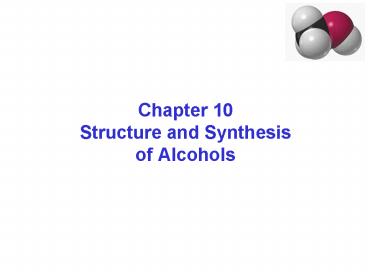Chapter 10 Structure and Synthesis of Alcohols - PowerPoint PPT Presentation
1 / 38
Title:
Chapter 10 Structure and Synthesis of Alcohols
Description:
Primary: carbon with OH is bonded to one other carbon. ... IUPAC Nomenclature. Find the longest carbon chain containing the carbon with the -OH group. ... – PowerPoint PPT presentation
Number of Views:41
Avg rating:3.0/5.0
Title: Chapter 10 Structure and Synthesis of Alcohols
1
Chapter 10Structure and Synthesis of Alcohols
2
Structure of Alcohols
- Hydroxyl (OH) functional group
- Oxygen is sp3 hybridized.
gt
3
Classification
- Primary carbon with OH is bonded to one other
carbon. - Secondary carbon with OH is bonded to two other
carbons. - Tertiary carbon with OH is bonded to three
other carbons. - Aromatic (phenol) -OH is bonded to a benzene
ring.
4
Classify these
5
IUPAC Nomenclature
- Find the longest carbon chain containing the
carbon with the -OH group. - Drop the -e from the alkane name,
- add - ol.
- Number the chain, starting from the end closest
to the -OH group. - Number and name all substituents. gt
6
Name these
2-methyl-1-propanol
2-butanol
2-methyl-2-propanol
3-bromo-3-methylcyclohexanol
gt
7
Unsaturated Alcohols
- Hydroxyl group takes precedence over double and
triple bonds. - Assign carbon with OH the lowest number.
- Use alkene or alkyne name.
4-penten-2-ol (old)
pent-4-ene-2-ol (1997 revision of IUPAC rules)
gt
8
Common Names
- Alcohol can be named as alkyl alcohol.
- Useful only for small alkyl groups.
- Examples
isobutyl alcohol
9
Naming Diols
- Two numbers are needed to locate the two -OH
groups. - Use -diol as suffix instead of -ol.
1,6-hexanediol
gt
10
Glycols
- 1, 2 diols (vicinal diols) are called glycols.
- Common names for glycols use the name of the
alkene from which they were made.
1,2-propanediol
1,2-ethanediol
ethylene glycol
propylene glycol
11
Naming Phenols
- -OH group is assumed to be on carbon 1.
- For common names of disubstituted phenols, use
ortho- for 1,2 meta- for 1,3 and para- for 1,4. - Methyl phenols are cresols.
4-methylphenol
para-cresol gt
3-chlorophenol
meta-chlorophenol
12
Physical Properties
- Unusually high boiling points due to hydrogen
bonding between molecules. - Small alcohols are miscible in water, but
solubility decreases as the size of the alkyl
group increases.
gt
13
Boiling Points
14
Solubility in Water
15
Commercially Important Alcohols-Methanol
- Wood alcohol
- Industrial production from synthesis gas
- Common industrial solvent
- Common starting material for other chemicals
- Fuel at Indianapolis 500
16
Ethanol
- Fermentation of sugar and starches in grains
- 12-15 alcohol, then yeast cells die.
- Distillation produces hard liquors
- Azeotrope 95 ethanol, constant boiling
- Denatured alcohol used as solvent
- Gasahol 10 ethanol in gasoline
17
2-Propanol
- Rubbing alcohol
- Catalytic hydration of propene
18
Acidity of Alcohols
- pKa range 15.5-18.0 (water 15.7)
- Acidity decreases as alkyl group length
increases. - Halogens increase the acidity.
- Phenol is very acidic (carbolic acid) 100 million
times more acidic than cyclohexanol!
19
Table of Ka Values
gt
20
Formation of Alkoxide Ions
- React alcohol with sodium metal (redox reaction).
React less acidic alcohols with more reactive
potassium.
21
Formation of Phenoxide Ion
- Phenol reacts with hydroxide ions to form
phenoxide ions - no redox is necessary.
O
O
H
O
H
H
O
H
p
K
1
5
.
7
a
p
K
1
0
a
gt
22
Organometallic Reagents
- Carbon is bonded to a metal (e.g. Na, Mg or Li).
- Carbon is nucleophilic (partially negative).
- It will attack a partially positive carbon.
- C - X
- C O
- A new carbon-carbon bond forms.
gt
23
Grignard Reagents
- Formula RMgX (reacts like R- MgX)
- Stabilized by anhydrous ether
- May be formed from any organic halide
- primary
- secondary
- tertiary
- vinyl
- aryl
gt
24
Some Grignard Reagents
25
Reaction with Carbonyl
- R- attacks the partially positive carbon in the
carbonyl. - The intermediate is an alkoxide ion.
- Addition of water or dilute acid protonates the
alkoxide to produce an alcohol.
26
Synthesis of 1 Alcohols
- Grignard formaldehyde yields a primary alcohol
with one additional carbon.
27
Synthesis of 2º Alcohols
- Grignard aldehyde yields a secondary alcohol.
28
Synthesis of 3º Alcohols
- Grignard ketone yields a tertiary alcohol.
29
Grignard Acid Chloride (1)
- Grignard attacks the carbonyl.
- Chloride ion leaves.
Ketone intermediate gt
30
Second step of reaction
- Second mole of Grignard reacts with the ketone
intermediate to form an alkoxide ion. - Alkoxide ion is protonated with dilute acid.
31
Grignard Reagent Ethylene Oxide
- Epoxides are unusually reactive ethers.
- Product is a 1º alcohol with 2 additional carbons.
32
Reduction of Carbonyl
- Reduction of aldehyde yields 1º alcohol.
- Reduction of ketone yields 2º alcohol.
- Reagents
- Sodium borohydride, NaBH4
- Lithium aluminum hydride, LiAlH4
- Raney nickel, Ni
gt
33
Sodium Borohydride
- Hydride ion, H-, attacks the carbonyl carbon,
forming an alkoxide ion. - Then the alkoxide ion is protonated by dilute
acid. - Only reacts with carbonyl of aldehyde or ketone,
not with carbonyls of esters or carboxylic acids.
34
Lithium Aluminum Hydride
- Stronger reducing agent than sodium borohydride,
but dangerous to work with. - Converts esters and acids to 1º alcohols.
LiAlH4
35
Comparison of Reducing Agents
- LiAlH4 is stronger.
- LiAlH4 reduces more stable compounds which are
resistant to reduction.
gt
36
Catalytic Hydrogenation
- Add H2 with Raney nickel catalyst.
- Also reduces any CC bonds.
37
Thiols (Mercaptans)
- Sulfur analogues of alcohols, -SH.
- Named by adding -thiol to alkane name.
- The -SH group is called mercapto.
- More acidic than alcohols, react with NaOH to
form thiolate ion. - Stinks!
38
Thiol Synthesis

